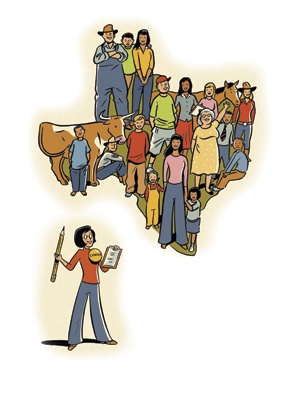Disaster often punctuates the importance of participating in the U.S. census that’s conducted every 10 years.
In 2005, Hurricane Rita blew through southeast Texas, uprooting trees and tossing them onto roofs, destroying many homes and leaving many scared and injured people in its wake. “Hardin County had about 14,000 homes damaged in the county, and we only had 19,000 to begin with,” said County Judge Billy Caraway, who estimated total losses to property and forestland in his county at about $100 million. Hardin County ended up with about $7 million in federal disaster relief just for helping people with housing repairs. The money, in the form of community development block grants (CDBGs), was distributed by the U.S. Department of Housing and Urban Development to affected counties based on census population.
“This got them back into a place where they could live, which was their home originally,” Caraway said.
Likewise, the devastation in neighboring Jasper County was “phenomenal”—more than $100 million in losses to property and forestland, according to County Judge Mark Allen. As in Hardin County, CDBGs were distributed in Jasper County based on its population in the 2000 census. The county was allocated about $6 million to help improve and repair damage to public roads and public infrastructure caused by Rita. “If in 2000 we had not had the support we needed to give an accurate census count, we could have received much less (aid) than we did,” Allen said.
The funding, Allen said, made a real difference to people in his county, who otherwise would have had to use local money for repairs. “They went from complete despair to gratitude and just a feeling of relief,” he said.
The census affects individuals’ representation in local, state and federal governments. Census data also determines how much money local and state governments are allocated from more than $400 billion in federal funds distributed across the country each year. The money goes toward transportation, education, health, emergency services, disaster relief and more. By participating in the census, you help ensure that your community gets its share.
Population is almost always in the formula for federal community grants of any kind, not just those for disaster relief, Allen said, adding, “I’m encouraging all of our people to get out there and be counted for the 2010 census.”
Curious how it all works? Kyle Mence and Ivonne Espada-Simeon, East Texas and Central Texas partnership specialists, respectively, for the U.S. Census Bureau, fielded questions from Texas Co-op Power and explained what to expect with the 2010 census.
Why is there a census?
Ivonne: Article 1, Section 2 of the U.S. Constitution mandates that every resident of the United States participates in a census in every year ending in 0. The first census was taken in 1790.
Why do you say “resident” and not “citizen”?
Ivonne: If you reside here in the United States during the time of the census, you are going to be counted. It’s just a snapshot of what the United States of America looks like at the time, regardless of citizenship. The census is used to allocate major federal and other funds to be distributed to communities every year for the next 10 years. The reality is, regardless of residency status, people residing here use public roads, public services, hospitals, schools and the like, all of which need funding.
Kyle: And also, the number of seats in the House of Representatives each state has is based on census figures. That’s what originally brought about the census in 1790, so that each representative would be representing approximately the same number of people.
How will the census this year differ from the one in 2000?
Kyle: In the last census, most households received the short form, containing 10 basic questions. But one in six households received a longer form.
Ivonne: This time, everybody is mailed a questionnaire with just 10 basic questions relating to such factors as age, gender, race, ethnicity and if you’re a property renter or owner, for example. It does not ask about citizenship. It is shorter and easier to do than the long form some people received in 2000. However, a longer questionnaire is sent by the American Community Survey to one in six households every year, so some homes will receive both a census form and an ACS form this year.
Why should rural residents participate?
Ivonne: The big concern is that people are migrating to more urbanized areas, so you’re losing population, you’re losing youth, you’re losing people who are able to uphold the local economy. Residents of rural areas can apply for so many federal programs to help sustain their communities. These can improve their farm-to-market roads and cooperative extension programs and provide financial aid for students to attend rural or agricultural university programs, to name a few. For every person who participates in the census, their community gets more and more dollars for those kinds of needs. So for rural Texans, participating in the census is a huge deal. The more people who participate, the more it ensures that the rural way of life continues.
What are the challenges of getting an accurate count in rural areas?
Ivonne: We don’t deliver the census to P.O. boxes, so the census has to be hand delivered to some rural homes.
Kyle: Some other hurdles are low population density in rural areas, a lot of space between houses, and of course, locked gates, which present a problem not only to electric companies but to census workers. And there are language and literacy barriers, and also fear of the government.
How does fear relate to the census?
Ivonne: There are many people residing in the United States who have a fear of government in some shape or form. Examples include concerns about immigration and deportation, tax evasion, delinquent child support, arrest warrants and so many other concerns. These represent a general mistrust of government. However, we as Census Bureau employees are sworn to protect the identities of everyone who participates in the census.
Kyle: We do not share information that is personally identifiable with any other agency—federal, state or local.
Does the census even ask for personal information?
Kyle: No census worker will ever ask for Social Security numbers or for banking information, period.
Ivonne: The form asks for a name and phone number, and the reason we ask for that is just for quality check. We do checks to make sure we’re not getting two or three instances of the same person being counted.
What if people cannot read in English?
Ivonne: The form is printed in five languages other than English. If you live in an area that is Spanish speaking, you’ll get a bilingual questionnaire. But there are many other languages spoken in Texas, and we can accommodate people by phone this year in 59 languages other than English.
What can people do to help ensure their community gets a complete count?
Kyle: Forms will go out in mid-March. Census day is April 1. We hope all of the forms would be mailed back by that time. Part of our grassroots effort is getting neighbor to help neighbor through word-of-mouth. We would like people to look for the census forms, help their neighbors who have some sort of barrier, language or otherwise, reach out to shut-ins to help them get counted, and encourage your neighbors, family and friends to cooperate with census authorities.
For more information, go to www.census.gov.
Texas Stats
Statehood: December 29, 1845
POPULATION BY DECENNIAL CENSUS
| 2000 | 20,851,820 |
| 1950 | 7,711,194 |
| 1900 | 3,048,710 |
| 1850 | 212,592 |
The projected Texas population for 2030 is more than 33 million.
RURAL POPULATION OF TEXAS
| Year | Urban % | Rural % |
|---|---|---|
| 2000 | 82.5 | 17.5 |
| 1950 | 62.7 | 37.3 |
| 1910 | 24.1 | 75.9 |
| 1900 | 17.1 | 82.9 |
| 1850 | 3.6 | 96.4 |
RACIAL MIX OF TEXAS
(in 2008)
| Race | Percentage |
|---|---|
| White* | 82.4 |
| Black | 11.9 |
| Asian | 1.3 |
| Persons reporting two or more races | 1.3 |
| American Indian and Alaska Native | 0.8 |
| Native Hawaiian and Other Pacific Islander | 0.1 |
* The U.S. Census Bureau divides the racial category “white” into Hispanic and non-Hispanic ethnicities; persons of Hispanic origin may be of any race.
Source: U.S. Census Bureau
——————–
Staci Semrad is a member of Pedernales Electric Cooperative.


